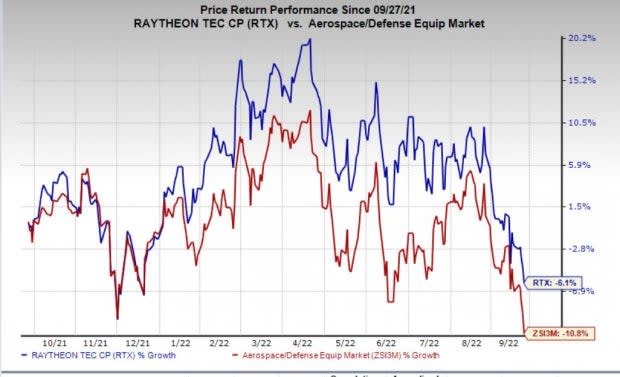Raytheon (RTX) Clinches $160M Contract for Dual Band Radar
Raytheon Technologies Corp. RTX recently secured a contract involving Dual Band Radar (DBR). The Naval Sea Systems Command, Washington, D.C has provided the award.
Details of the Deal
Valued at $160.2 million, the contract is expected to be completed by September 2023. Per the terms, Raytheon will offer design agent and technical engineering efforts to support the DBR systems installed aboard CVN-78 and DDG-1000 class ships.
The contract includes options, which on being exercised, would bring the cumulative value of the deal to $440 million. The major portion of the contract will be executed in Tewksbury, MA.
Significance of Dual Band Radar
The DBR program is the first radar system of the U.S. Navy fleet, capable of operating simultaneously on two frequency ranges (S-band and X-band) coordinated by a single-resource manager. It combines the functionality of the X-band AN/SPY-3 Multifunction Radar and the S-band Volume Surveillance Radar (VSR) to provide an unprecedented level of performance and capability to detect as well as track hostile targets.
DBR can operate 24x7 during extended missions with an operational availability that is greater than 95%. Additionally, DBR requires no dedicated operator or manned display consoles and is directed by the command and control-level personnel through the Ship Self Defense System, an open-architecture solution that integrates the ship's systems through a single enterprise network.
Raytheon’s remarkable features that can effectively assist in military operations have resulted in a steady inflow of orders involving the radar system. The latest contract win is an example of that. This, in turn, will boost RTX’s revenues from the radars arena.
Prospects
Nations are strengthening their defense capabilities amid rising geopolitical tensions. In this context, demand for an effective radar system, which boasts the features of next-generation technology-based warfare capabilities, has been gaining momentum due to the system’s growing importance in military surveillance.
Per a Mordor Intelligence report, the global military radars market is anticipated to witness a CAGR of 4.5% during the 2022-2031 period. This exhibits strong growth prospects for Raytheon Technologies, which boasts a product portfolio consisting of varied radars like integrated air and missile defense radars, ballistic missile radars, surveillance radars and air dominance radars. Such diversity in radar system technology tends to provide Raytheon a competitive edge in the military radar system market.
The aforementioned growth prospects should also benefit other radar-manufacturing defense majors. These are:
Northrop Grumman NOC: The company has been at the forefront of active electronically scanned array radar innovations for more than 60 years. The AESA radars provide unparalleled battlespace situational awareness and air-to-air as well as air-to-ground superiority. A few of Northrop Grumman’s renowned radars are the AN/AAQ-24(V) Directional Infrared Countermeasure system, the AN/APG-77 AESA radar and the AN/APG-81 AESA fire control radar.
Northrop Grumman has a long-term earnings growth rate of 2.2%. NOC’s investors have gained 34.1% in the past year.
Lockheed Martin LMT is pioneering the latest radar systems and technology. Its product portfolio consists of varied radars like Longbow FCR, AN/APY-9, IRST21 Sensor System, LANTIRN ER, Legion Pod and M-TADS/PNVS, which are some of its combat-proven products that enjoy solid demand in the global military radar market.
Lockheed Martin’s long-term earnings growth rate is pegged at 5.4%. Shares of LMT have returned 16.9% value to investors in the past year.
BAE Systems BAESY is at the forefront of radar tracking technology, delivering systems that provide precision tracking data to range commanders with superior situational awareness and various target-tracking solutions. It delivered numerous state-of-the-art land-based fixed, transportable, mobile and shipborne precision Time Space and Position Information tracking radar systems to domestic and international customers.
BAE Systems boasts a long-term earnings growth rate of 9.3%. BAESY stock has appreciated 9.9% in the past year.
Price Movement
In the past year, shares of Raytheon Technologies have lost 6.1% compared with the industry’s decline of 10.8%.

Image Source: Zacks Investment Research
Zacks Rank
Raytheon Technologies currently carries a Zacks #3 (Hold). You can see the complete list of today’s Zacks #1 Rank (Strong Buy) stocks here
Want the latest recommendations from Zacks Investment Research? Today, you can download 7 Best Stocks for the Next 30 Days. Click to get this free report
Lockheed Martin Corporation (LMT) : Free Stock Analysis Report
Northrop Grumman Corporation (NOC) : Free Stock Analysis Report
Bae Systems PLC (BAESY) : Free Stock Analysis Report
Raytheon Technologies Corporation (RTX) : Free Stock Analysis Report
To read this article on Zacks.com click here.
Zacks Investment Research

 Yahoo Finance
Yahoo Finance 